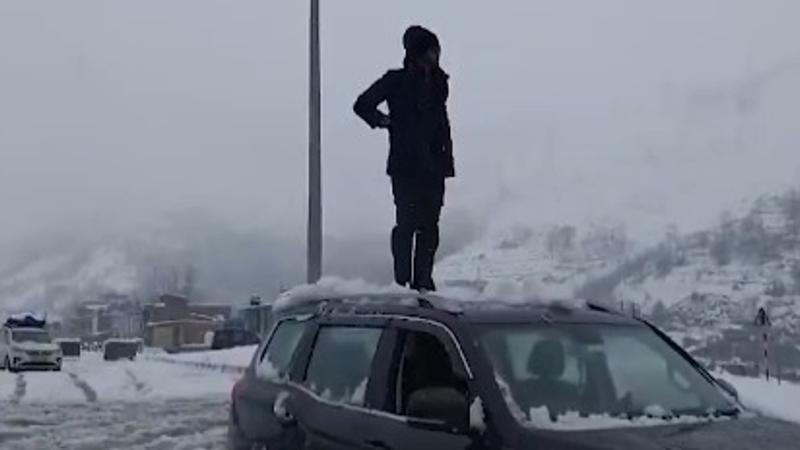Published 20:56 IST, December 28th 2024
Thousands stranded on hills as season's heaviest snow disrupts air, rail, road traffic in J&K, Himachal
Daily life was thrown out of gear in Kashmir as the season's heaviest snowfall hit air, rail and road traffic and disrupted.

New Delhi: Daily life was thrown out of gear in Kashmir as the season's heaviest snowfall hit air, rail and road traffic and disrupted power and water supply on Saturday while Uttarakhand shivered due to snow and intermittent rain causing temperatures to dip.
Madhya Pradesh recorded overnight showers due to a western disturbance and other weather phenomena. Rain also lashed parts of Punjab and Haryana for a second consecutive day while several places in Rajasthan received light to moderate showers.
Delhi, meanwhile, recorded 41.2 mm rainfall in the 24 hours ended at 8:30 am. An active western disturbance and its interaction with easterly winds are causing light to moderate rainfall and thunderstorms over northwest and central India, including Delhi-NCR, the India Meteorological Department (IMD) said.
Moderate to heavy snowfall was recorded across Kashmir from Friday.
In south Kashmir, heavy to very heavy snowfall was recorded in the plains while central Kashmir's plains received moderate snowfall. The plains of north Kashmir received light to moderate snowfall, officials said.
The Jammu-Srinagar national highway was closed for traffic due to snow. The snow clearance work was hampered due to heavy snowfall at the Navyug Tunnel, they said.
Train services on the Banihal-Baramulla section were suspended due to heavy snow accumulation on the tracks, railway officials said.
Air traffic to and from Srinagar was also affected, with flight operations suspended, airport officials said.
Stuck in the snow, while many sulked, some chose to allay their hardships by playing cricket inside the out-of-bounds 8.5-kilometre Navyug Tunnel in Kashmir. The tunnel connects Banihal town in Ramban district of Jammu with Qazigund in south Kashmir's Anantnag district.
Many were forced to spend the night inside their vehicles in the freezing temperature.
In a heartwarming display of Kashmiri hospitality, locals in Gund, on the Srinagar-Sonamarg highway, opened the doors of a mosque to shelter a group of travellers from Punjab stranded due to the heavy snowfall.
Directing the deputy commissioners to personally supervise snow clearance operations, Chief Minister Abdullah stressed the importance of ensuring 100 per cent attendance of doctors and paramedical staff at district and sub-district hospitals.
He issued instructions to the Budgam deputy commissioner to coordinate with the airport authorities to assist stranded tourists.
In a post on X, he said most of the dysfunctional power feeders in the valley had been restored.
He also made an unannounced visit to the district hospital in Ganderbal and assessed the services available during the inclement weather and reviewed the availability of essential medicines, staff on duty, and functionality of the central heating system.
In Uttarakhand, most hill districts were in the grip of severe cold due to continuous snowfall in the upper reaches of the mountains and intermittent light showers, coupled with cool winds sweeping the lower areas.
The higher reaches of the hills of Auli, Harshil, Hemkund Sahib, Chopta, Dayara, Lokhandi, Sukki Top, Munsyari and Pithoragarh were blanketed with snow.
The Badrinath national highway was closed between Pandukeshwar and Badrinath because of accumulation of snow, which was being cleared.
The Joshimath-Niti highway connecting the border with China was also shut beyond Suraithotha while the Chamoli-Kund national highway connecting Kedarnath and Badrinath was closed between Dhotidhar and Makku Bend.
Rain affected electricity supply in 10 villages of Nauti area of Karnaprayag. A fault in a 33 kV line disrupted power supply in all villages of Dewal development block.
Electricity supply was also disrupted in 20 villages of Dungari area of Tharali development block and 21 villages in Sankot area of Narayanbagh.
In Delhi, the day was overcast and chilly after the city recorded its highest single-day December rainfall in 101 years.
The national capital recorded 41.2 mm rain in the 24 four hours ended at 8:30 am, causing daytime temperatures to remain below normal.
The IMD said the city recorded the highest single-day December rainfall on December 3, 1923, at 75.7 mm.
"The 24-hour cumulative rainfall ending at 8:30 am is the second-highest since 1901 at Safdarjung. The monthly rainfall is the fifth-highest," an IMD official said.
Delhi's maximum temperature was recorded at 15.8 degrees Celsius, 4.6 notches below normal.
The minimum temperature was higher than usual on account of the rain at 12.7 degrees Celsius, six notches above average.
In Rajasthan, Jhalawar district recorded 86 mm rainfall. Some places in the state's eastern parts, including Dausa and Alwar, reported hailstorms.
Dense to very dense fog was recorded in some areas.
Chandigarh -- the common capital of Punjab and Haryana -- recorded a maximum temperature of 15.1 degrees Celsius.
In Punjab, Amritsar registered a day temperature of 14.8 degrees Celsius while Ludhiana recorded 15.4 degrees.
In Haryana, the maximum temperature in Ambala was recorded at 15.3 degrees Celsius, Hisar 16.5 degrees, Karnal 14.6 degrees, Rohtak 15.7 degrees, Sirsa 17.4 degrees and Gurugram 15.8 degrees.
Chandigarh, Patiala, Pathankot, Fatehgarh Sahib, Rupnagar, Ambala, Karnal, Sirsa and Yamunanagar recorded rainfall during the day.
Get Current Updates on India News, Entertainment News along with Latest News and Top Headlines from India and around the world.
Updated 20:56 IST, December 28th 2024




